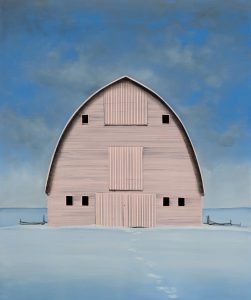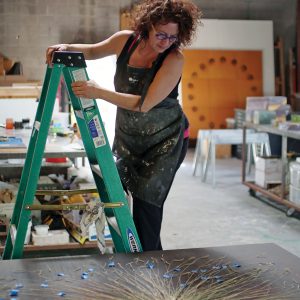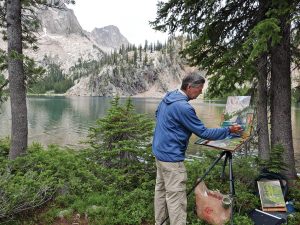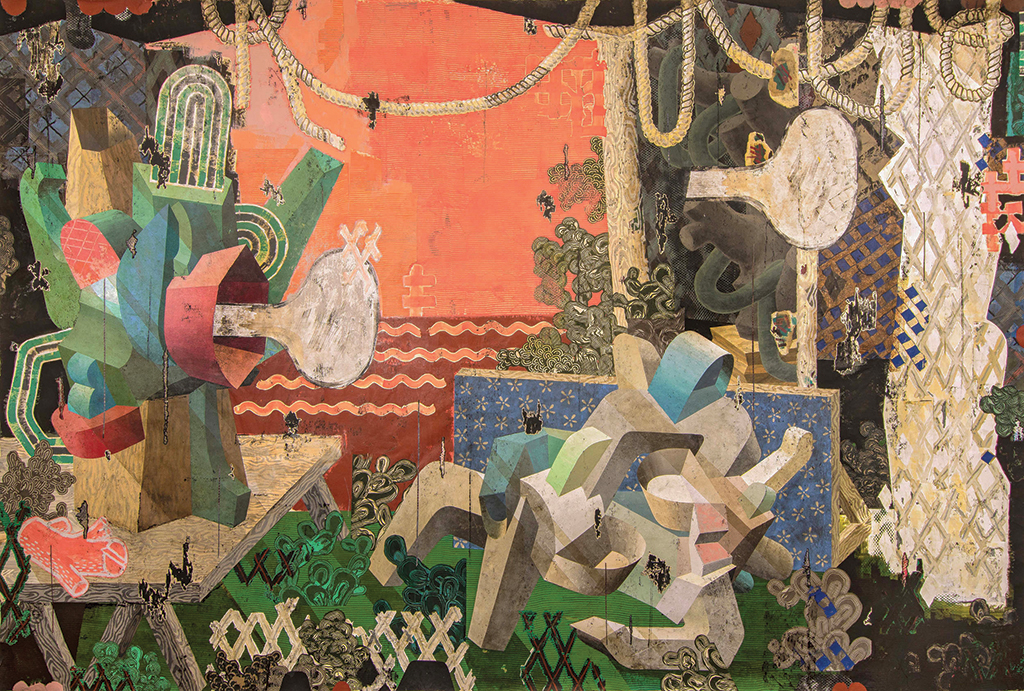“When I enter the studio, I do not so much begin with an idea as an endeavor to arrive at one.” Artist David Hytone, now being featured at Friesen Gallery, approaches his art with a focus on the process, rather than the result. Using a variety of “off-canvas” processes in his work, including glass-plate paint transfer, crude mono-print techniques, and the application of painted paper to the piece’s surface, Hytone is able to create beyond the canvas. In doing so, he plays with the intersection between specificity and approximation, abstraction and representation. These techniques involve transference and obfuscation, thus producing compromised or incomplete images that reflect Hytone’s themes of human impermanence and limitation. His artistic journey led him to the Minneapolis College of Art and Design for a BFA in Fine Arts, then on to solo and group exhibitions all over the country. He even landed a spot as a finalist for the 2018 Neddy Award in Painting. Today, his work resides in collections such as Capital One, Swedish hospitals, Hilton, and the permanent collection of King County, WA. In his themes of theater and still-life, Hytone asks his viewers to reconsider common tropes and reflect on the nature of human endeavors in an impermanent world.
Upon first look at Michael Gregory’s paintings, you might recognize the classic American imagery of barns, landscapes, and fields, but his scenes are actually imagined collages of various places Gregory has encountered throughout his life. Michael Gregory combines personal observations, experiences, art history, and his own interests into his paintings. Having taken road trips throughout the American West and Midwest, he’s melded those environments with invented landscapes from memory. Gregory explores themes of isolation, exploration, and the human experience in his work. The small architectural details of homes and ranches in his paintings, set amongst vast skylines and landscapes, remind the viewer of the smallness of human existence. These details also suggest the strength required of the individuals living in these regions. Above all, much of Gregory’s work is symbolic of Americana, westward expansion, and hope. As far as Gregory’s own hopes for his work, he doesn’t wish to tell stories in his paintings. Rather, he hopes to suggest “a point of departure for a topic for conversation.” He advises viewers to consider the icons in his paintings as points for meditation and reflection.

Having hiked and camped in many national parks and open spaces throughout the Southwest, Mayme Kratz has found a way to blend the personal with the artistic. While hiking throughout the desert, Kratz would collect roots, leaves, bones, flowers, and other natural materials, which she would go on to incorporate in her work by crafting the pieces into patterns and shapes and then casting them in resin. Her pieces bring beauty to the often-overlooked remnants of nature, transforming simple materials into stunning works of art. Those Southwest desert hikes also provided Kratz with time to reflect on her own smallness in the face of the natural world, noticing the beauty, fragility, yet simultaneous harshness of her environment. These observations are reflected in her work, which often grapples with the feeling of human existence as infinitely small in comparison to our surroundings. Kratz found her own style and method in sculptural and two-dimensional mixed-media polymer resin works after an apprenticeship with artist James Hubbell in San Diego in her early twenties. Her dedication to preserving and highlighting natural debris that would otherwise be ignored or thrown away ultimately led to her award of the Arlene and Morton Scult Contemporary Forum Art Award by the Phoenix Art Museum in 2010. Now, Kratz has collections in the Phoenix Art Museum, Scottsdale Museum of Contemporary Art, Tucson Museum of Art, and San Jose Museum of Art.

Ralph Oberg called the Wood River Valley home for several years in the early 1970s, and he now returns to showcase his landscapes and wildlife paintings with Wood River Fine Arts. Before his days as a painter, Oberg worked as a technical draftsman, a graphic designer, a bird renderer, a wildlife artist, and a plein air landscape sketcher. However, he maintained a love for the outdoors, specifically the mountains, that would lure him to attempt to represent its beauty through painting. In 1973, while climbing in the Alaska Range, Oberg experienced the awe of glaciers and ice-covered mountains. Since that point, he knew his life’s work would focus on that subject matter. Oberg reflected on the tendency for artists, including himself, to represent the past or the fleeting in their work. Knowing that the glaciers he saw in 1973 continue to shrink and recede each day made Oberg wish to paint them in an effort to document their beauty and wonder. And Oberg successfully captured such beauty in A Remnant of Wilderness, as he was recently honored at the 2020 Prix de West Show in Oklahoma City with the Wilson Hurley Memorial Award for Landscape.



